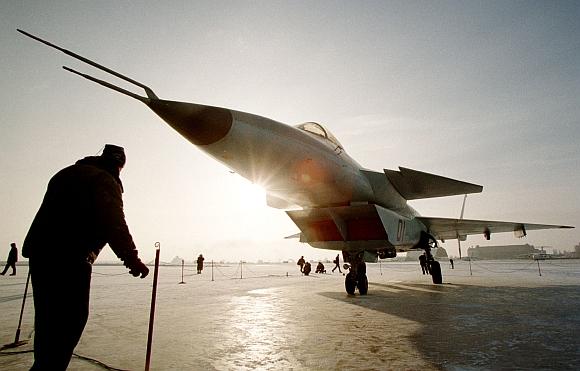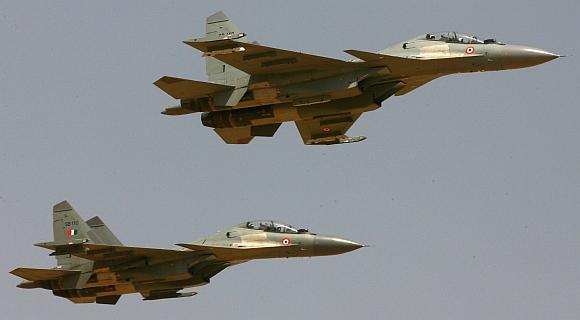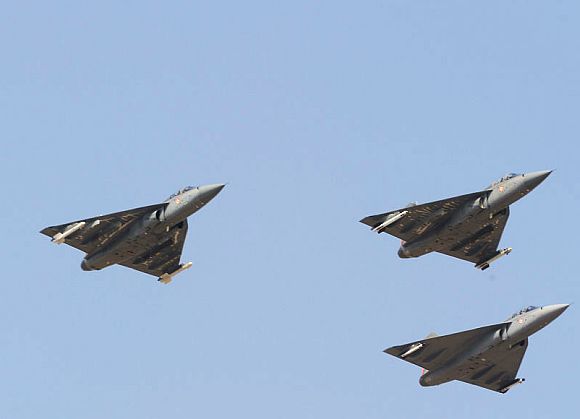
Seven years before its scheduled completion, the Ministry of Defence has already announced a two-year delay in the Fifth Generation Fighter Aircraft (FGFA) India and Russia are to jointly develop, says Ajai Shukla
Defence Minister A K Antony has been saying the FGFA would join the Indian Air Force by 2017. On Monday, his deputy, M M Pallam Raju, told Parliament, "The fifth generation aircraft is scheduled to be certified by 2019, following which the series production will start."
The FGFA is the flagship of the Indo-Russian partnership. Both countries say it would be the world's most advanced fighter. But interviews with Indian designers who have overseen the project suggest significant disquiet. There is apprehension the FGFA would significantly exceed its current $6 million budget, because this figure reflects the expenditure on just the basic aircraft.
Crucial avionics systems would cost extra. On the positive side, Indian designers say the FGFA project would provide invaluable experience in testing and certifying a heavy fighter aircraft that is bigger and more complex than the Tejas light combat aircraft, India's foundational aerospace achievement.
The Russian and Indian air forces each plan to build about 250 FGFAs, at an estimated cost of $100 million per fighter. That adds up to $25 billion each, in addition to the development cost.
...

The FGFA's precursor has already flown. In January 2010, Russian company Sukhoi test-flew a prototype called the PAK-FA, the acronym for Perspektivnyi Aviatsionnyi Kompleks Frontovoi Aviatsy (literally prospective aircraft complex of frontline aviation).
Now, Hindustan Aeronautics Limited will partner Sukhoi to transform the bare-bones PAK-FA into an FGFA that meets the IAF's requirements of stealth (near-invisibility to radar), super-cruise (supersonic cruising speed), networking (real-time digital links with other battlefield systems) and world-beating airborne radar that outranges enemy fighters.
But Sukhoi insists the PAK-FA already meets Russia's requirements, says N C Agarwal, HAL's design chief, who spearheaded the FGFA negotiations until his recent retirement.
HAL worries Russia might ask India to pay extra for further development, particularly the avionics that transform a mere flying machine into a lethal weapons platform. That would leave the $6-billion budget in tatters.
The IAF clearly wants a top-of-the-line FGFA. According to Ashok Nayak, who spoke to Business Standard as HAL's chairman before retiring last October, the IAF has specified 40-45 improvements that must be made to the PAK-FA. These have been formalised into an agreed list between Russia and India, the Tactical Technical Assignment.
...

A key IAF requirement is a '360-degree' Airborne electronically Scanned Active radar, rather than the AESA radar that Russia developed. Either way, India would pay Russia extra: either in licence fee for the Russian radar; or hundreds of millions, perhaps billions, for developing a world-beating, 360-degree AESA radar.
Nor is the IAF clear on whether the FGFA should be a single-seat fighter like the PAK-FA, or a twin-seat aircraft like the Sukhoi-30MKI. A section of the IAF backs a single-seat fighter, while another prefers two pilots for flying and fighting a complex, networked fighter.
During the ongoing Preliminary Design Phase, for which India paid $295 million, the two sides would determine whether developing the PAK-FA into a twin-seat aircraft (inevitably more bulky) would reduce the FGFA's stealth and performance unacceptably.
"The single-seat FGFA is essential for the IAF, and we will transform the Russian single-seat fighter into our single-seat version with a large component of Indian avionics. The twin-seat version will depend on the PDP conclusions," says Nayak.
The PDP also requires Sukhoi to hand over design documentation to HAL, providing it a detailed insight into the design processes of the PAK-FA. Since India took years to decide to join the FGFA project, HAL missed out the design phase entirely.
The 18-month PDP, which terminates this year, will be followed by the 'R & D phase', which could take another seven years, says the HAL chairman. The FGFA would be designed in both countries. About 100 HAL engineers already operate from a facility in Bangalore. Another contingent would move to Russia to work in the Sukhoi design bureau.
...

"Our boys will learn the Russian language, their way of working, their design rules and their design norms. We are left-hand drive, while they are right-hand drive. The Russians say they would part with all these things," says Nayak.
But the most valuable learning, say HAL executives, would take place during the FGFA's flight-testing. "Unlike the basic design phase which we missed out on, we will actually gain experience during flight testing. This phase throws up dozens of problems, and we will participate in resolving these, including through design changes," says Agarwal.
HAL designers also relish the FGFA's specific challenges. For achieving stealth, its missiles, rockets and reconnaissance payloads are concealed in an internal bay under the wings. Before using these, a door slides open, exposing the weapon for use.
The Russians clearly believe HAL possesses useful capabilities, including the ability to design the AESA radar. Also attractive is India's experience in composites.
"The LCA programme has generated a high level of expertise in composite materials within the National Aerospace Laboratory and some joint teams. The FGFA requires 'higher modulus' composites, which can withstand the 120-130 degree Centigrade temperatures that arise whilst flying at Mach 1.7 speeds," says Agarwal.
Despite the continuing imponderables, HAL believes the FGFA project provides genuine technological skills, far more useful than licensed manufacture. Agarwal says, "We will pay some $6-7 billion to France for the licence to build the Rafale in HAL. In the FGFA project, a similar sum would bring in genuine design knowledge that will help us in the future."
...